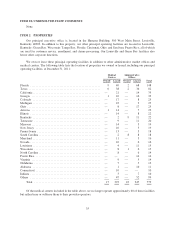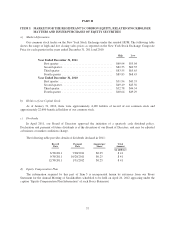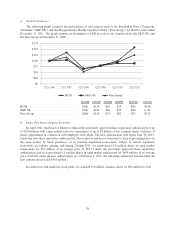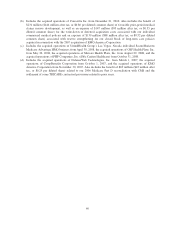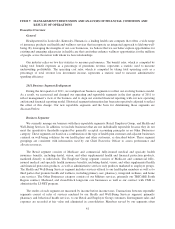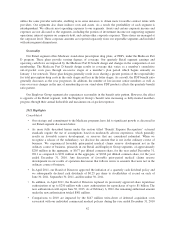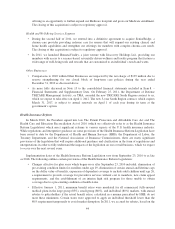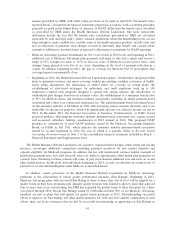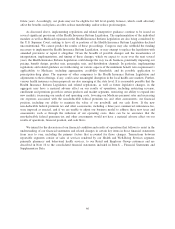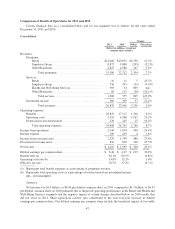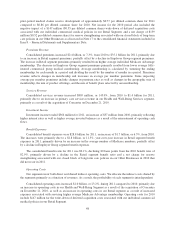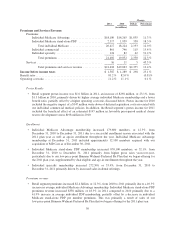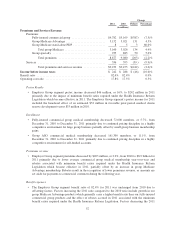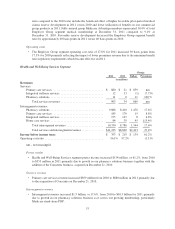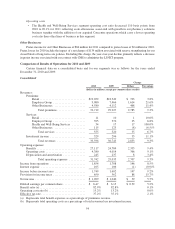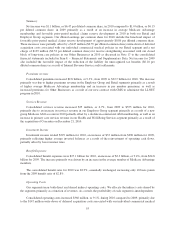Humana 2011 Annual Report Download - page 55
Download and view the complete annual report
Please find page 55 of the 2011 Humana annual report below. You can navigate through the pages in the report by either clicking on the pages listed below, or by using the keyword search tool below to find specific information within the annual report.manner prescribed by HHS, with initial rebate payments to be made in mid-2012. Our benefit ratios
reported herein, calculated from financial statements prepared in accordance with accounting principles
generally accepted in the United States of America, or GAAP, differ from the benefit ratios calculated
as prescribed by HHS under the Health Insurance Reform Legislation. The more noteworthy
differences include the fact that the benefit ratio calculations prescribed by HHS are calculated
separately by state and legal entity; reflect actuarial adjustments where the membership levels are not
large enough to create credible size; exclude some of our health insurance products; include taxes and
fees as reductions of premium; treat changes in reserves differently than GAAP; and classify rebate
amounts as additions to incurred claims as opposed to adjustments to premiums for GAAP reporting.
• Medicare Advantage payment benchmarks for 2011 were frozen at 2010 levels and beginning in 2012,
additional cuts to Medicare Advantage plan payments will begin to take effect (plans will receive a
range of 95% in high-cost areas to 115% in low-cost areas of Medicare fee-for-service rates), with
changes being phased-in over two to six years, depending on the level of payment reduction in a
county. In addition, beginning in 2011, the gap in coverage for Medicare Part D prescription drug
coverage began to incrementally close.
• Beginning in 2014, the Health Insurance Reform Legislation requires: all individual and group health
plans to guarantee issuance and renew coverage without pre-existing condition exclusions or health-
status rating adjustments; the elimination of annual limits on coverage on certain plans; the
establishment of state-based exchanges for individuals and small employers (with up to 100
employees) coupled with programs designed to spread risk among insurers; the introduction of
standardized plan designs based on set actuarial values; the establishment of a minimum benefit ratio
of 85% for Medicare plans; and insurance industry assessments, including an annual premium-based
assessment and a three-year commercial reinsurance fee. The annual premium-based assessment levied
on the insurance industry is $8 billion in 2014 with increasing annual amounts thereafter and is not
deductible for income tax purposes, which will significantly increase our effective income tax rate in
2014. In December 2011, the National Association of Insurance Commissioners, or NAIC, issued
proposed guidance indicating the insurance industry premium-based assessment may require accrual
and associated subsidiary funding consideration in 2013 instead of 2014. This proposed NAIC
guidance is contradictory to final GAAP guidance issued by the Financial Accounting Standards
Board, or FASB, in July 2011, which indicates the insurance industry premium-based assessment
should be accrued beginning in 2014, the year in which it is payable. Refer to Recently Issued
Accounting Pronouncements in Note 2 to the consolidated financial statements included in Item 8. –
Financial Statements and Supplementary Data.
The Health Insurance Reform Legislation also specifies required benefit designs, limits rating and pricing
practices, encourages additional competition (including potential incentives for new market entrants) and
expands eligibility for Medicaid programs. In addition, the law will significantly increase federal oversight of
health plan premium rates and could adversely affect our ability to appropriately adjust health plan premiums on
a timely basis. Financing for these reforms will come, in part, from material additional fees and taxes on us and
other health insurers, health plans and individuals beginning in 2014, as well as reductions in certain levels of
payments to us and other health plans under Medicare as described herein.
In addition, certain provisions in the Health Insurance Reform Legislation tie Medicare Advantage
premiums to the achievement of certain quality performance measures (Star Ratings). Beginning in 2012,
Medicare Advantage plans with an overall Star Rating of three or more stars (out of five) will be eligible for a
quality bonus in their basic premium rates. Initially quality bonuses were limited to the few plans that achieved
four or more stars as an overall rating, but CMS has expanded the quality bonus to three Star plans for a three
year period through 2014. Recent Star Ratings issued by CMS indicated that 98% of our Medicare Advantage
members are now in plans that will qualify for quality bonus payments in 2013. Notwithstanding successful
efforts to improve our Star Ratings and other quality measures for 2012 and 2013 and the continuation of such
efforts, there can be no assurances that we will be successful in maintaining or improving our Star Ratings in
45


